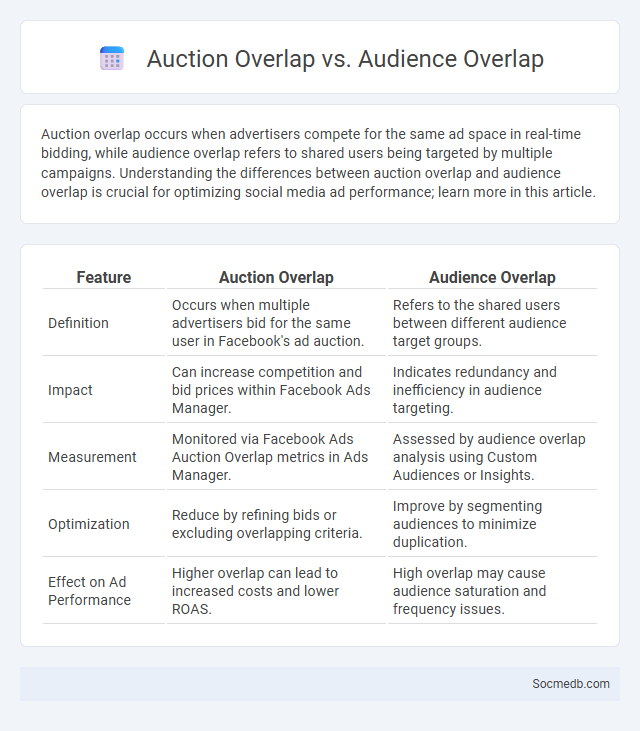
Photo illustration: Auction Overlap vs Audience Overlap
Auction overlap occurs when advertisers compete for the same ad space in real-time bidding, while audience overlap refers to shared users being targeted by multiple campaigns. Understanding the differences between auction overlap and audience overlap is crucial for optimizing social media ad performance; learn more in this article.
Table of Comparison
| Feature | Auction Overlap | Audience Overlap |
|---|---|---|
| Definition | Occurs when multiple advertisers bid for the same user in Facebook's ad auction. | Refers to the shared users between different audience target groups. |
| Impact | Can increase competition and bid prices within Facebook Ads Manager. | Indicates redundancy and inefficiency in audience targeting. |
| Measurement | Monitored via Facebook Ads Auction Overlap metrics in Ads Manager. | Assessed by audience overlap analysis using Custom Audiences or Insights. |
| Optimization | Reduce by refining bids or excluding overlapping criteria. | Improve by segmenting audiences to minimize duplication. |
| Effect on Ad Performance | Higher overlap can lead to increased costs and lower ROAS. | High overlap may cause audience saturation and frequency issues. |
Introduction to Auction Overlap, Audience Overlap, and Ad Auction
Auction overlap occurs when multiple advertisers bid on the same audience segment in social media ad auctions, increasing competition and driving up costs. Audience overlap refers to the extent to which different ad campaigns target the same users, potentially leading to ad fatigue and reduced overall ROI. Understanding ad auction mechanics helps you optimize your bidding strategies to maximize reach and minimize wasted spend in crowded marketplaces.
Defining Auction Overlap in Digital Advertising
Auction overlap in digital advertising occurs when multiple advertisers target the same audience segment simultaneously, leading to competing bids within a social media platform's ad auction system. This competition influences your ad delivery, affecting both cost-per-click (CPC) and overall campaign performance by increasing bid prices and reducing ad visibility. Understanding auction overlap helps optimize budget allocation and improve targeting precision to maximize your advertising ROI.
Audience Overlap: Understanding Shared Audiences
Audience Overlap in social media refers to the shared followers or users between different accounts, pages, or channels, indicating common interests and engagement patterns. By analyzing this overlap, you can optimize your content strategy to target unique segments and reduce redundant messaging, maximizing your reach and efficiency. Understanding your audience overlap helps in refining your marketing efforts for better customer engagement and ROI.
What is an Ad Auction?
An ad auction is a digital marketplace where advertisers compete to display their ads to a specific audience on social media platforms like Facebook, Instagram, or Twitter. Your bid, combined with factors such as ad relevance and estimated action rates, determines whether your ad wins the auction and gets shown. This process ensures that users see the most relevant ads, optimizing both user experience and advertiser return on investment.
Key Differences Between Auction Overlap and Audience Overlap
Auction overlap occurs when multiple advertisers compete for the same ad impression in a social media auction, driving up costs and affecting bid strategy efficiency. Audience overlap refers to the extent to which different campaigns target the same group of users, potentially leading to audience fatigue and diminished ad performance. Managing Your campaigns by understanding auction overlap helps optimize bidding, while monitoring audience overlap ensures diversification and improved reach.
The Role of Ad Auction in Online Advertising
The role of ad auctions in online advertising is crucial for determining which ads are displayed to users based on factors like bid amount, relevance, and quality score. Social media platforms such as Facebook, Instagram, and Twitter utilize real-time auctions to optimize ad placements, maximizing advertiser ROI and user engagement. Understanding how the ad auction process works can help you craft more effective campaigns that reach your target audience efficiently.
How Auction Overlap Impacts Campaign Performance
Auction overlap in social media advertising occurs when multiple ads from your campaigns compete for the same audience, leading to increased competition and higher costs per impression. This overlap can dilute your campaign performance by causing bid inflation, reduced ad delivery efficiency, and lower overall return on ad spend (ROAS). Understanding and minimizing auction overlap is crucial for optimizing your targeting strategy and maximizing the effectiveness of your social media campaigns.
Effects of Audience Overlap on Ad Spend Efficiency
Audience overlap in social media advertising can significantly reduce ad spend efficiency by causing multiple ads to compete for the same users, leading to increased costs and diminished returns. Platforms like Facebook and Instagram utilize advanced algorithms to identify and minimize audience overlap, optimizing ad delivery and budget allocation. Understanding the degree of overlap enables advertisers to refine targeting strategies, improve click-through rates, and maximize overall campaign performance.
Strategies to Minimize Overlap and Optimize Ad Auctions
Implementing frequency capping ensures ads are shown a limited number of times to the same user, reducing audience overlap and preventing wasted impressions. Utilizing audience segmentation and exclusion lists helps target distinct user groups, optimizing budget allocation across campaigns. Leveraging platform-specific auction insights, such as Facebook's bid strategy and Google's ad rank, improves ad placement efficiency and maximizes return on ad spend.
Best Practices for Managing Overlap in Digital Campaigns
Managing overlap in digital campaigns requires advanced audience segmentation to minimize redundant targeting and optimize ad spend efficiency. Leveraging cross-channel data integration ensures consistent messaging while preventing audience fatigue and frequency capping issues. Employing AI-driven attribution models further enhances campaign precision by accurately distributing credit across multiple touchpoints.
 socmedb.com
socmedb.com